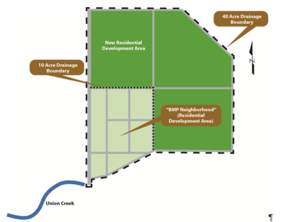
Difference between revisions of "Scenario for developing a stormwater treatment train for constructed ponds in new development"
(Created page with "==Treatment Train Scenarios== ===New Development & Stormwater Ponds in Series Scenarios=== ====Step 1: Review Project Goals & Site Conditions==== This scenario is for a new...") |
|||
| Line 5: | Line 5: | ||
====Step 1: Review Project Goals & Site Conditions==== | ====Step 1: Review Project Goals & Site Conditions==== | ||
| − | This scenario is for a new residential development in the rural town in central Minnesota. The new development is to be 40 acres with four 10-acre sub-neighborhoods. The upstream neighborhoods have slopes of 2% draining to the downstream southwest neighborhood, hereby referred to as the “BMP Neighborhood.” The basic site conditions for the New Development setting are summarized in Table 3.5.1. For this scenario two treatment train options will be evaluated: a Varied BMP Approach and Stormwater Ponds in Series Approach. The existing site layout for the New Development scenario can be seen in | + | This scenario is for a new residential development in the rural town in central Minnesota. The new development is to be 40 acres with four 10-acre sub-neighborhoods. The upstream neighborhoods have slopes of 2% draining to the downstream southwest neighborhood, hereby referred to as the “BMP Neighborhood.” The basic site conditions for the New Development setting are summarized in Table 3.5.1. For this scenario two treatment train options will be evaluated: a Varied BMP Approach and Stormwater Ponds in Series Approach. The existing site layout for the New Development scenario can be seen in the New Residential Development Scenario Base schematic. |
| + | |||
| + | [[File:New Residential Development Scenario Base.PNG|right|thumb|300 px|alt=This schematic shows a New Residential Development Scenario Base|<font size=3>New Residential Development Scenario Base</font size>]] | ||
| + | |||
| + | At the southwest corner of the BMP Neighborhood is an outlet to Union Creek, which continues southwest to a small lake. This lake is known to be nutrient impaired with excess levels of phosphorous possibly due to fertilizer use from upstream lawns, gardens and agricultural areas. The use of fertilizers is not uncommon and often necessary as sandy soils are generally not productive for vegetation growth. Interception of nutrients through BMPs before entering the stream system is a | ||
Revision as of 20:55, 14 July 2015
Treatment Train Scenarios
New Development & Stormwater Ponds in Series Scenarios
Step 1: Review Project Goals & Site Conditions
This scenario is for a new residential development in the rural town in central Minnesota. The new development is to be 40 acres with four 10-acre sub-neighborhoods. The upstream neighborhoods have slopes of 2% draining to the downstream southwest neighborhood, hereby referred to as the “BMP Neighborhood.” The basic site conditions for the New Development setting are summarized in Table 3.5.1. For this scenario two treatment train options will be evaluated: a Varied BMP Approach and Stormwater Ponds in Series Approach. The existing site layout for the New Development scenario can be seen in the New Residential Development Scenario Base schematic.
At the southwest corner of the BMP Neighborhood is an outlet to Union Creek, which continues southwest to a small lake. This lake is known to be nutrient impaired with excess levels of phosphorous possibly due to fertilizer use from upstream lawns, gardens and agricultural areas. The use of fertilizers is not uncommon and often necessary as sandy soils are generally not productive for vegetation growth. Interception of nutrients through BMPs before entering the stream system is a
